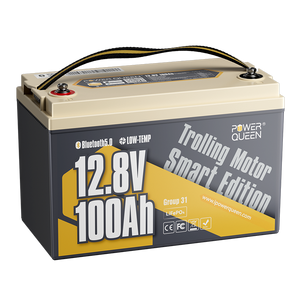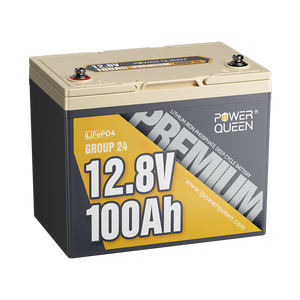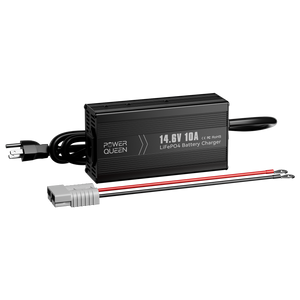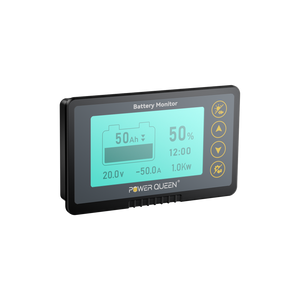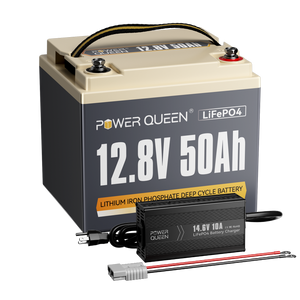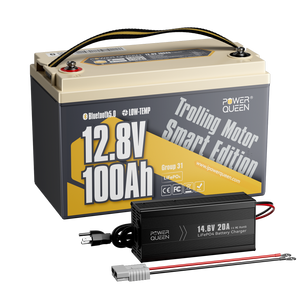How Long Will 4 Parallel 12V 100Ah Lithium Batteries Last
Determining how long 4 parallel 12V 100Ah lithium batteries will last depends on several factors, including battery capacity, power demand, and environmental conditions. This guide explains important ideas like parallel connections, runtime calculations, and real-life examples. It will help you get the most out of your battery system.
Table of Content
- Part 1. What Does Parallel Connection Mean for Batteries?
- Part 2. Benefits of Parallel Battery Connection
- Part 3. Factors That Affect Battery Runtime
- Part 4. Steps to Calculate 4 Parallel 12V 100Ah Lithium Batteries Runtime
- Part 5. Application Scenarios for 4 Parallel 12V 100Ah Lithium Batteries
- Part 6. FAQs
- Part 7. In Conclusion
Part 1. What Does Parallel Connection Mean for Batteries?
Connecting batteries in parallel involves linking all positive terminals together and all negative terminals together. This configuration increases the overall capacity while keeping the voltage the same. For example, connecting four 12V 100Ah batteries in parallel results in:
- Voltage: 12V
- Capacity: 400Ah (100Ah × 4)

This setup is ideal for systems requiring extended runtime without increasing voltage. By combining multiple batteries in this way, you can support high-demand applications without needing specialized high-voltage equipment.
Related Reading: Know Everything about Wiring Batteries in Series VS Parallel
Part 2. Benefits of Parallel Battery Connection
2.1 Increased Capacity for Extended Runtime
A key benefit of a parallel battery connection is the ability to increase the system’s overall capacity without altering its voltage. For example, four 12V 100Ah batteries in parallel provide a 400Ah capacity at 12V. This higher capacity allows the system to power devices for a longer time, making it ideal for applications like RVs, off-grid solar systems, and backup power setups.
With Power Queen 12V 100Ah Group 24 LiFePO4 Battery, you can achieve optimal performance thanks to its lightweight design, stable output, and advanced BMS protection. This battery offers twice the energy of traditional lead-acid batteries while ensuring durability with over 4000 cycles at 100% depth of discharge, making it a reliable choice for high-demand applications.



2.2 Flexibility in Scaling Up the System
Parallel connections make it easy to expand energy storage as your needs grow. Starting with a smaller setup and adding more batteries over time is a cost-effective way to build a larger energy system. Each additional battery increases capacity, enabling longer runtime or support for higher loads, without requiring significant modifications to existing components.
2.3 Enhanced System Redundancy
A parallel battery connection provides redundancy. If one battery fails, the remaining batteries can continue powering the system. This ensures an uninterrupted power supply for critical applications like medical devices, communication systems, or essential home appliances, offering peace of mind during unexpected failures.
2.4 Balanced Discharge Across Batteries
In a well-maintained parallel system, the load is evenly distributed across all connected batteries. This balanced discharge prevents overburdening any single battery, helping extend the lifespan of the entire system. By sharing the workload, the batteries operate more efficiently, avoiding unnecessary wear and tear.
2.5 Cost-Effective Upgrades
Compared to increasing system voltage, adding capacity through parallel connections is more budget-friendly. It avoids the need for expensive upgrades to inverters or charge controllers, which might be necessary when changing the voltage. This makes parallel connections an economical choice for expanding energy storage systems.
Part 3. Factors That Affect Battery Runtime
3.1 Load Demand
The power demand of connected devices significantly influences battery runtime. Low-demand devices like LED lights or small electronics use less energy, allowing the battery system to last longer. In contrast, high-demand devices such as refrigerators or power tools draw more energy, reducing runtime. For example:
- 50W device: A 50W device at 12V draws approximately 4.17 amps (50W ÷ 12V). With 400Ah available, the batteries can last around 96 hours (400Ah ÷ 4.17A).
- 500W device: A 500W device at 12V draws 41.67 amps. The same battery setup would last about 9.6 hours (400Ah ÷ 41.67A).
3.2 Depth of Discharge (DOD)
The depth to which you discharge your battery before recharging affects both runtime and lifespan. While lithium batteries can handle deep discharges, repeatedly draining them below 80% of capacity can shorten their lifespan. Limiting DOD to around 80% ensures a good balance between usable energy and long-term performance.
3.3 Temperature and Environmental Conditions
Temperature extremes can significantly impact battery performance. In cold environments, chemical reactions slow down, reducing capacity. Conversely, high temperatures accelerate degradation, permanently reducing capacity. For optimal performance, maintain the batteries within a temperature range of 50℉ to 86℉ (10℃ to 30℃).
A key benefit of Power Queen lithium batteries is their reliability in extreme weather conditions. Unlike lead-acid batteries, which lose performance at high or low temperatures, lithium batteries maintain their efficiency over a wider temperature range.
Related Reading: Storing LiFePO4 Batteries: A Guide to Proper Storage
Part 4. Steps to Calculate 4 Parallel 12V 100Ah Lithium Batteries Runtime
4.1 Step 1: Determine the Total Capacity
To calculate runtime, first determine the system’s total capacity. For four 12V 100Ah batteries connected in parallel, the total capacity is:
100Ah × 4 = 400Ah
This means the system can deliver 400 amp-hours of energy at 12 volts.
4.2 Step 2: Calculate Load Power
Next, identify the wattage of the devices you plan to power. For multiple devices, add their wattage together. For example, a 100W fan and a 300W refrigerator would require a total load of:
100W + 300W = 400W
4.3 Step 3: Apply the Formula
Using the formula below, estimate runtime based on the total capacity and load:
Runtime (hours) = Total Capacity (Ah) × Battery Voltage (V) ÷ Load Power (W)
For a 400Ah system powering a 400W load:
Runtime = (400Ah × 12V) ÷ 400W = 12 hours
Part 5. Application Scenarios for 4 Parallel 12V 100Ah Lithium Batteries
5.1 RV and Camper Systems
In RVs and campers, these batteries provide a reliable solution for powering essential systems like lights, kitchen appliances, and even air conditioning. With a 400Ah capacity, you can enjoy extended trips without worrying about running out of power, even in remote areas where hookups aren’t available.
RV batteries from Power Queen are an ideal choice, offering a lightweight and compact design compatible with multiple sizes. These batteries deliver stable performance in low temperatures, feature a premium BMS system for safety, and are IP65 waterproof and dustproof, making them perfect for powering essential systems during your adventures.
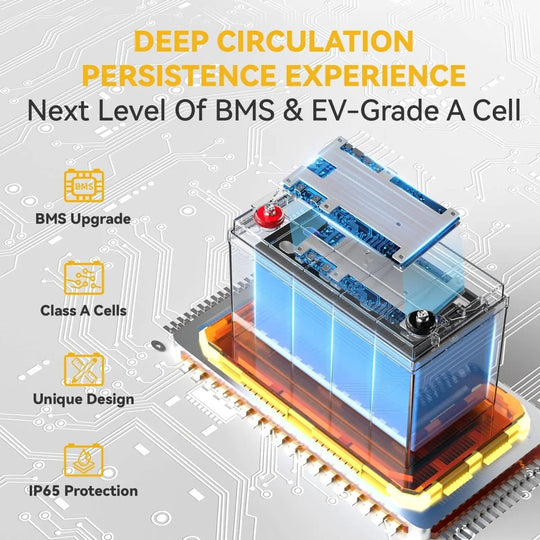
Related Reading: How Long Do RV Batteries Last
5.2 Off-Grid Solar Systems
Off-grid solar setups benefit greatly from these batteries as they store excess energy generated during the day. This stored energy can power devices at night or on cloudy days, ensuring uninterrupted operation for essential systems like refrigerators, communication equipment, and lighting.
5.3 Emergency Backup Power
For emergency preparedness, these batteries offer dependable backup power during outages. They can keep critical devices running, such as medical equipment, sump pumps, and small appliances. Their long lifespan and ability to maintain stable power make them an excellent choice for safeguarding against unexpected disruptions.
Part 6. FAQs
6.1 What Is the Runtime of a 12V 100Ah Lithium Battery in Parallel?
Each additional battery in parallel increases capacity by 100Ah. Four batteries provide 400Ah, and runtime depends on the load’s power consumption.
6.2 How Does Temperature Affect Lithium Battery Runtime?
Cold temperatures reduce capacity, while high temperatures accelerate wear. Maintaining an optimal temperature range is crucial.
6.3 How Can I Improve the Runtime of My 12V 100Ah Lithium Battery System?
Use energy-efficient devices, maintain proper temperature, and perform regular maintenance.
6.4 What Is the Role of the Battery Management System (BMS) in Battery Runtime?
The BMS ensures safe operation by preventing overcharging and deep discharging, though it consumes a small amount of energy itself.
Part 7. In Conclusion
Four parallel 12V 100Ah lithium batteries offer a reliable and versatile energy solution for RVs, off-grid solar setups, and emergency backup systems. Their runtime depends on factors like load demand, depth of discharge, and environmental conditions. By understanding how to calculate runtime, optimize system performance, and maintain the batteries properly, you can ensure long-lasting and efficient power for your needs.




